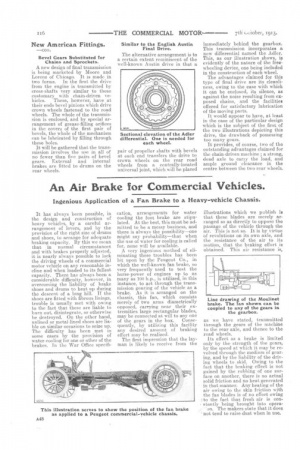An Air Brake for Commercial Vehicles.
Page 16

If you've noticed an error in this article please click here to report it so we can fix it.
Ingenious Application of a Fan Brake to a Heavy-vehicle Chassis.
It has always been possible, in the design and construction of heavy vehicles, by a careful arrangement of levers, and by the provision of the right size of drums and shoes, to arrange for adequate braking capacity. By this we mean that in normal circumstances and with brakes properly adjusted, it is nearly always possible to lock the driving wheels of a commercial motor vehicle on any reasonable incline and when loaded to its fullest capacity. There has always been a considerable difficulty, however, in overcoming the liability of brake shoes and drums to heat up during the descent of a long hill. If the shoes are fitted with fibrous linings, trouble is usually met with owing to the fact that these are liable to burn out, disintegrate, or otherwise be destroyed. On the other hand, unlined or metal-lined shoes are liable on similar occasions to seize up. The difficulty has been met in seine cases by the provision of water-cooling for one or other of the brakes. In the War Office specifi cation, arrangements for water cooling the foot brake are stipulated. At the best, this must be admitted to be a messy business, and there is always the possibility—one might say probability—that when the use of water for cooling is called for, none will be available.
A very ingenious method of eliminating these troubles has been hit upon by the Peugeot Co., in which the well-known fan brake, so very frequently used to test the horse-power of engines up to as many as 100 lep., is utilized, in this instance, to act through the transmission gearing of the vehicle as a brake. As it is arranged on the chassis, this fan, which consists merely of two arms diametrically opposed, carrying near their extremities large rectangular blades, may be connected at will to any one of the gears in the box. Consequently, by utilizing this facility any desired amount of braking effort may be realized.
The first impression that the layman is likely to receive from the
illustrations which we publish is that these blades are merely arranged so as directly to oppose tho passage of the vehicle through the air. This is not so. It is by virtue Of revolutions on its own axle, and the resistance of the air to its motion, that the braking effort is obtained. This air resistance is,
as we have stated, transmitted
through the gears of the machine to the rear axle, and thence to the road wheels.
Its effect as a brake is limited only by the strength of the gears, by the speed at which it may be revolved through the medium of gearing, and by the liability of the driving wheels to skid. Owing to the fact that the braking effect is not gained by the rubbing of one surface on another, there is no actual solid friction and no heat generated in that manner. Any heating of the air owing to the skin friction with the fan blades is of no effect owing to the fact that fresh air is constantly being brought into opera'on. The makers state that it does not tend to raise dust when in use.




















